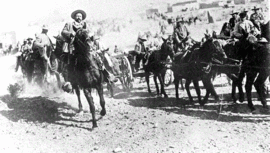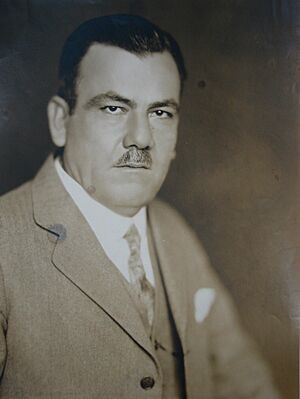Second Battle of Agua Prieta facts for kids
Quick facts for kids Second Battle of Agua Prieta |
|||||||
|---|---|---|---|---|---|---|---|
| Part of the Mexican Revolution | |||||||
 Pancho Villa and his army in northern Mexico. |
|||||||
|
|||||||
| Belligerents | |||||||
|
|
|
||||||
| Commanders and leaders | |||||||
| Strength | |||||||
| 15,000 | 6,500 | ||||||
| Casualties and losses | |||||||
| unknown | 45 dead 90 wounded |
||||||
The Second Battle of Agua Prieta happened on November 1, 1915. It was a key fight during the Mexican Revolution. The battle was between the forces of Pancho Villa and those led by Plutarco Elías Calles. Calles later became the President of Mexico. He supported Venustiano Carranza.
The battle took place in Agua Prieta, Sonora. Villa's attack on the town was stopped by Calles's army. This victory helped Carranza gain more control over Mexico. It also led to the United States recognizing Carranza as Mexico's president. Villa believed the U.S. helped Calles because Agua Prieta is right next to Douglas, Arizona. This belief later caused Villa to attack Columbus, New Mexico.
Contents
Why the Battle Happened

After General Victoriano Huerta was defeated, the revolutionary groups in Mexico started fighting each other. Emiliano Zapata and Pancho Villa joined forces. They were called the "Conventionalistas." But they clashed with the "Constitutionalists" or "Carrancistas." This group was led by Venustiano Carranza. Carranza saw himself as the rightful leader of Mexico.
At first, Villa and Zapata were winning. They took over Mexico City. This forced Carranza and his supporters to leave for Veracruz. But things started to change in early 1915. Villa suffered a big defeat at the Battle of Celaya in April. By October 1915, Villa only controlled his home state of Chihuahua. The city of Juárez was his only way to get weapons from the U.S.
U.S. Changes Its Mind
Before late 1915, Villa had good relations with the U.S. He even thought U.S. President Woodrow Wilson was a friend to the poor. In April 1915, Wilson even warned that the U.S. might step in if the civil war continued. Villa hoped this would stop Carranza's advance.
Villa believed that if he could take control of northern Mexico, the U.S. would recognize him as president. However, he was running out of money. He needed money to buy weapons and pay his soldiers. So, in mid-1915, he started taking over farms and factories. Many of these were partly owned by Americans. This made the U.S. government feel pressure to support Carranza instead.
Other reasons for the U.S. policy change included support for Carranza from American labor unions. There were also worries about German spies in Mexico during World War I. Carranza also promised to protect foreign properties in Mexico. Plus, Carranza's generals were winning battles. Villa did not know that in October 1915, the U.S. officially recognized Carranza as Mexico's president.
U.S. Helps Carranza
U.S. support for Carranza went beyond just recognizing him. The U.S. stopped selling weapons to Villa. More importantly, President Wilson allowed Carranza's troops to travel through American land. This helped strengthen the defenses at Agua Prieta. About 3,500 experienced soldiers traveled through Arizona and New Mexico. They arrived in Agua Prieta in early October. This brought the total number of defenders to 6,500.
Villa did not know about these extra troops. An American reporter and friend of Villa, John W. Roberts, said Villa thought only 1,200 soldiers defended the town.
Also, the U.S. was worried about bullets and shells crossing the border. U.S. General Frederick Funston placed troops in Douglas, Arizona. These included infantry (foot soldiers), cavalry (horse soldiers), and artillery (big guns). The American troops did not fight. But their presence made Villa believe the Americans helped Carranza's forces a lot. This made Villa very angry at the U.S.
The Battle of Agua Prieta
General Plutarco Calles led the defenders at Agua Prieta. Many of his soldiers were veterans. They had already beaten Villa at the Battle of Celaya. Calles used ideas from General Alvaro Obregon's experience at Celaya. He built strong defenses around the city. These included deep trenches, barbed wire, and many machine gun nests.
Villa arrived at Agua Prieta on October 30. He gave his men a day to rest. During this time, he finally learned that the U.S. had recognized Carranza. But he still did not know that Carranza's extra troops had crossed American land. So, Villa still believed a quick cavalry charge in the dark could capture the city easily. His officers thought the town would be taken in five hours.
The next day, Villa started his attack with an artillery barrage. This was in the early afternoon. It only set off some of the land mines that Carranza's forces had placed around the town. Once it was dark, Villa made some fake attacks in different places. This was to hide where his main attack would come from. Shortly after midnight, on November 2, he launched his main attacks. These were frontal assaults from the east and south of Agua Prieta.
Villa's Attack Fails
As Villa's cavalry charged toward the trenches, two powerful searchlights lit up the battlefield. This made the horsemen easy targets for Calles's machine guns. The front trenches were defended by units led by Lázaro Cárdenas, who also became a future president of Mexico. Villa's horsemen were wiped out by machine-gun fire and land mines. The few who got close to the trenches found electrified barbed wire. The charge failed completely. The attack was a disaster.
Villa wanted to keep trying cavalry charges the next day. But his troops were ready to mutiny (rebel). He was also running low on supplies and ammunition. So, Villa pulled back his forces. He arrived at Naco on November 4. Even though his men rested and got supplies there, more than 1,500 soldiers left his army.
What Happened Next
While at Naco, Villa asked if his wounded soldiers could be transported by train through the United States to Juarez. He pointed out that Carranza had been allowed to move troops and supplies. But Villa's request was denied. After resting his troops, Villa gathered his remaining forces. He attacked the town of Hermosillo, Sonora, on November 21, 1915. To boost his soldiers' spirits, he promised them they could do whatever they wanted with the town and its people after they took it.
This promise actually caused the attack to fail. His men immediately started looting instead of fighting. This allowed the defending forces to get organized and drive Villa's soldiers out.
Villa's Anger at the U.S.
Most reports say the searchlights that helped Calles's machine guns were on the Mexican side of the border. However, Villa strongly believed they were on the American side. This, along with Wilson allowing Carranza to move troops through Arizona, completely changed Villa's view of the U.S. Before, Villa saw himself as a friend of Americans, even with small border raids for supplies. Now, he wanted revenge for what he saw as their betrayal.
Because of this, in March 1916, Villa led what was left of his army, the Division del Norte. They raided the American town of Columbus in New Mexico. Some say the raid was because of U.S. support for Carranza. Others say some Columbus residents had cheated Villa out of money he paid for weapons. This decision was a big mistake. Villa's forces were pushed back by the town's defenders. His already weakened army suffered heavy losses.
In response, the U.S. Army launched a punitive expedition into Mexico. It was led by General John J. Pershing. His orders were to capture or kill Villa. The expedition did not catch Villa himself. But it fought and destroyed most of what was left of Villa's army.


